NCERT Solutions | Class 8 Maths Chapter 4 | Practical Geometry

CBSE Solutions | Maths Class 8
Check the below NCERT Solutions for Class 8 Maths Chapter 4 Practical Geometry Pdf free download. NCERT Solutions Class 8 Maths were prepared based on the latest exam pattern. We have Provided Practical Geometry Class 8 Maths NCERT Solutions to help students understand the concept very well.
NCERT | Class 8 Maths
| Book: | National Council of Educational Research and Training (NCERT) |
|---|---|
| Board: | Central Board of Secondary Education (CBSE) |
| Class: | 8th |
| Subject: | Maths |
| Chapter: | 4 |
| Chapters Name: | Practical Geometry |
| Medium: | English |
Practical Geometry | Class 8 Maths | NCERT Books Solutions
NCERT Solutions for Class 8 Maths Chapter 4 Practical Geometry Exercise 4.1
Ex 4.1 Class 8 Maths Question 1.
Construct the following quadrilaterals:(i) Quadrilateral ABCD
AB = 4.5 cm
BC = 5.5 cm
CD = 4 cm
AD = 6 cm
AC = 7 cm
(ii) Quadrilateral JUMP
JU = 3.5 cm
UM = 4 cm
MP = 5 cm
PJ = 4.5 cm
PU 6.5 cm
(iii) Parallelogram MORE
OR = 6 cm
RE = 4.5 cm
EO = 7.5 cm
(iv) Rhombus BEST
BE = 4.5 cm
ET = 6 cm
Solution:

(i) First we draw a rough sketch of a quadrilateral ABCD and write down its dimensions as shown.
We may divide it into two conveniently constructible As ABC and ACD.
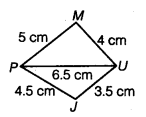
Steps of Construction :
- Draw AC = 7 cm.
- With A as centre and radius 4.5 cm, draw an arc (below AC).
- With C as centre and radius 5.5 cm, draw another arc cutting the previous arc at B.
- Join AB and BC.
- With A as centre and radius 6 cm, draw an arc (above AC).
- With C as centre and radius 4 cm, draw another arc cutting the previous arc at D.
- Join AD and CD.
Then, ABCD is the required quadrilateral.
(ii) First we draw a rough sketch of a quadrilateral JUMP and write down its dimensions as shown.
We may divide it into two conveniently constructible As PJU and PMU.
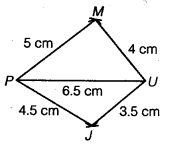
Steps of Construction :
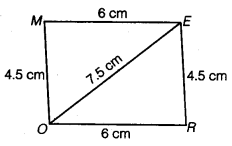
- Draw PU = 6.5 cm.
- With P as centre and radius 4.5 cm, draw an arc (below PU).
- With U as centre and radius 3.5 cm, draw another arc cutting the previous arc at J.
- Join PJ and JU.
- With P as centre and radius 5 cm, draw an arc (above PU).
- With U as centre and radius 4 cm, draw another me cutting the previous arc at M.
- Join PM and UM.
Then, JUMP is the required quadrilateral.
(iii) Draw a rough sketch of the’ required parallelogram and write down the given dimensions.
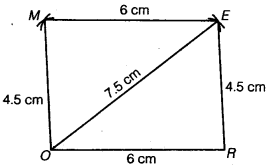
Steps of Construction :
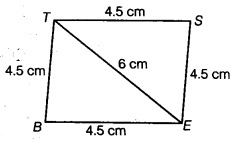
- Draw OR = 6 cm.
- With O as centre and radius 7.5 cm, draw an arc.
- With R as centre and radius 4.5 cm, draw another arc to cut the previous arc at E.
- Join OE and RE.
- With 0 as centre and radius 4 5 cm 4.5 cm, draw an arc.
- With E as centre and radius 6 cm, draw another arc to cut the previous arc at M.
- Join MO and ME.
Then, MORE is the required parallelogram.
(iv) Draw a rough sketch of the required rhombus and write down the given dimensions.
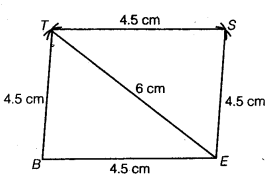
Steps of Construction :
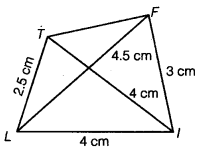
- Draw BE = 4.5 cm.
- With B as centre and radius 4.5 cm, draw an arc. 4 5 cm
- With E as centre and radius 6 cm, draw another arc to cut the previous arc at T.
- Join ST and ET.
- With T as centre and radius 4.5 cm, draw an arc.
- With E as centre and radius 4.5 cm, draw another arc to cut the previous arc at S.
- Join TS and ES.
Then, BEST is the required rhombus.
NCERT Solutions for Class 8 Maths Chapter 4 Practical Geometry Exercise 4.2
Ex 4.2 Class 8 Maths Question 1.
Construct the following quadrilaterals:(i) Quadrilateral LIFT
LI = 4 cm
IF = 3 cm
TL = 2.5 cm
LF = 4.5 cm
IT = 4 cm
(ii) Quadrilateral GOLD
OL = 7.5 cm
GL = 6 cm
GD = 6 cm
LD = 5 cm
OD = 10 cm
(iii) Rhombus BEND
BN – 5.6 cm
DE = 6.5 cm
Solution:
(i) Let us draw a rough sketch of the required quadrilateral and write down the dimensions. Clearly, the two easily constructible triangles are UT and LIF.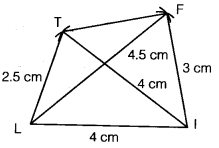
Steps of Construction :
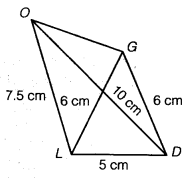
- Draw LI = 4 cm.
- With L as centre and radius 2.5 cm, draw an arc.
- With I as centre and radius 4 cm draw another arc to cut the previous arc at T.
- Join TL and 77.
- With L as centre and radius 4.5 cm, draw an arc.
- With I as centre and radius 3 cm, draw another arc to cut the previously drawn arc at F.
- Join FI, FL and TF.
Then, LIFT is the required quadrilateral.
(ii) Let us draw a rough sketch of the required quadrilateral and write down its dimensions. Clearly, the two easily constructible triangles are LOD and LGD.
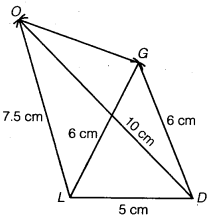
Steps of Construction :
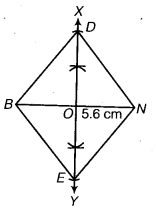
- Draw LD = 5 cm.
- With L as centre and radius 7.5 cm, draw an arc.
- With D as centre and radius 10 cm, draw another arc to cut the previous arc at O.
- Join OL and OD.
- With L as centre and radius 6 cm, draw an arc.
- With D as centre and radius 6 cm, draw an arc to cut the previously drawn arc at B.
- Join GD, GL and OG.
Then, GOLD is the required quadrilateral.
(iii) We know that the diagonals of a rhombus bisect each other at right angles. So, we proceed according to the following steps.
Steps of Construction :
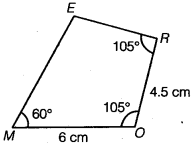
- Draw BN = 5.6 cm.
- Draw the right bisector XY of BN, meeting BN at O.
- From O set off OE = \frac { 1 }{ 2 } (6.5) cm = 3.25 cm along OY and OD = 3.25 cm along OX.
- Join BE, EN, ND and DB.
Then, BEND is the required rhombus.
NCERT Solutions for Class 8 Maths Chapter 4 Practical Geometry Exercise 4.3
Ex 4.3 Class 8 Maths Question 1.
Construct the following quadrilaterals :(i) Quadrilateral MORE
MO = 6 cm
OR = 4.5 cm
∠M = 60°
∠O = 105°
∠R = 105°
(ii) Quadrilateral PLAN
PL = 4 cm
LA = 6.5 cm
∠P = 90°
∠A = 110°
∠N – 85°.
(iii) Parallelogram HEAR
HE = 5 cm
EA = 6 cm
∠R = 85°
(iv) Rectangle OKAY
OK = 7 cm
KA = 5 cm.
Solution:
(i) Draw a rough sketch of the required quadrilateral and write down its dimensions.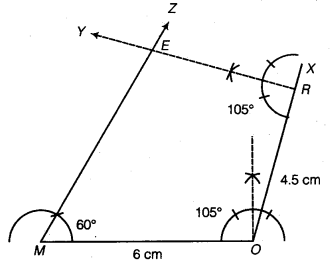
Steps of Construction :
- Draw MO = 6 cm.
- Make ∠MOX = 105°.
- With O as centre and radius 4.5 cm, cut off OR = 4.5 cm along OX.
- Make ∠ORY = 105°.
- Make ∠ZMO = 60° such that arms RY and MZ intersect at E.
Then, MORE is the required quadrilateral.
(ii) Draw a rough sketch of the required quadrilateral PLAN and write down its dimensions.
Before taking up the construction let us find the ∠PLA which is equal to 360° – (90°+ 110°+ 85°)
= 360°-285° = 75°.
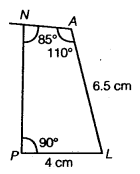
Steps of Construction :
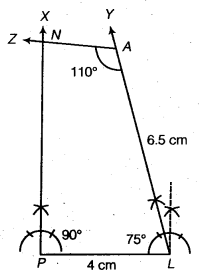
- Draw PL = 4 cm.
- Make ∠XPL =90°.
- Make ∠YLP = 75°.
- With L as centre and radius 6.5 cm, cut off LA – 6.5 cm along LY.
- Make ∠ZAL =110° and let its arm AZ intersect PX at N.
Then, PLAN is the required quadrilateral.
(iii) We know that the opposite angles of a parallelogram are equal. Make a rough sketch of the required parallelogram as shown.
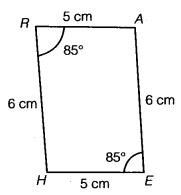
Steps of Construction :
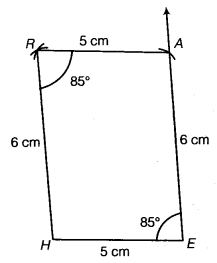
- Draw HE = 5 cm.
- Make ∠HEX = 85°.
- With E as centre and radius 6 cm, cut off EA = 6 cm along EX.
- With A as centre and radius 5 cm, draw an arc.
- With H as centre and radius 6 cm, draw another arc cutting the previous arc at R.
- Join HR and AR.
Then, HEAR is the required parallelogram.
(iv) We known that the opposite sides of a rectangle are equal and each angle of it is 90°.
Make a rough sketch of the required
rectangle and write down its dimensions.

Steps of Construction :
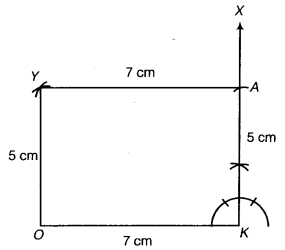
- Draw OK = 7 cm.
- Draw ∠OKX = 90°.
- With K as centre and radius 5 cm, draw an arc KX at A.
- With A as centre and radius 7 cm, draw an arc.
- With O as centre and radius 5 cm, draw another arc cutting the previous arc at Y.
- Join AY and OY.
Then, OKAY is the required rectangle.
NCERT Solutions for Class 8 Maths Chapter 4 Practical Geometry Exercise 4.4
Ex 4.4 Class 8 Maths Question 1.
Construct the following quadrilaterals:(i) Quadrilateral DEAR
DE = 4 cm
EA = 5 cm
AR = 4.5 cm
∠E = 60°
∠A = 90°
(ii) Quadrilateral TRUE
TR = 3.5 cm
RU = 3 cm
UE = 4 cm
∠R = 75°
∠U= 120°
Solution:
(i) Let us draw a rough sketch of the required quadrilateral and write down the given dimensions.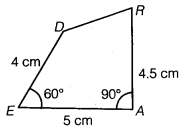
Steps of Construction :
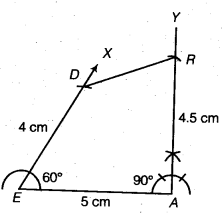
- Draw EA = 5 cm.
- Make ∠XEA = 60°.
- With E as centre and radius 4 cm, cut off ED = 4 cm along EX.
- Make ∠EAY = 90°.
- With A as centre and radius 4.5 cm, draw an arc to cut off AY at R.
- Join DR.
Then, DEAR is the required quadrilateral.
(ii) Let us draw a rough sketch of the required quadrilateral and write down the given 3 5 cm dimensions.
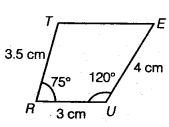
Steps of Construction :
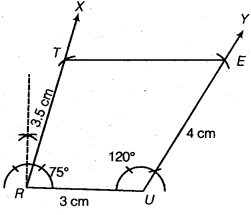
- Draw RU = 3 cm.
- Make ∠URX = 75°.
- With R as centre and radius 3.5 cm, cut off RT = 3.5 cm along RX.
- Make ∠RUY =120°
- With U as centre and radius 4 cm, draw an arc to cut CY at E Join TE.
- Then, TRUE is the required quadrilateral.
NCERT Solutions for Class 8 Maths Chapter 4 Practical Geometry Exercise 4.5
Ex 4.5 Class 8 Maths Question 1.
Draw the following:Solution:
Draw a rough sketch of the required square and write down its dimensions.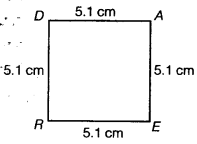
Steps of Construction :
- Draw RE = 5.1 cm.
- DrawRX ⊥RE.
- With R as centre and radius 5.1 cm, draw an arc to cut RX at D.
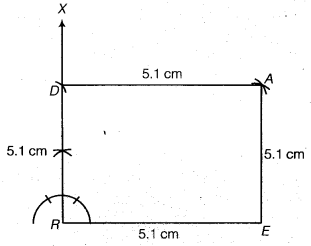
- With D as centre and radius 5.1 cm, draw an arc.
- With E as centre and radius 5.1 cm, draw another arc cutting the previous arc at A.
- Join DA and EA.
Then, READ is the required square.
Ex 4.5 Class 8 Maths Question 2.
A rhombus whose diagonals are 5.2 cm and 6.4 cm long.Solution:
Let diagonal AC = 5.2 cm and diagonal BD = 6.4 cm.Draw AC = 5.2 cm. Draw XY, the perpendicular bisector of AC which cuts AC at 0.
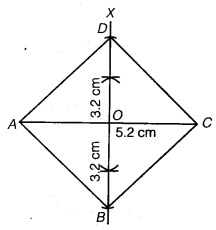
With O as centre, draw arcs of radii \left( =\frac { BD }{ 2 } =\frac { 6.4 }{ 2 } cm=3.2cm \right) which
cut OX at D and OY at B.
Join AB, BC, CD and DA.
Then, ABCD is the required rhombus.
Ex 4.5 Class 8 Maths Question 3.
A rectangle with adjacent sides of lengths 5 cm and 4 cm.Solution:
We know that the opposite sides of a Y rectangle are equal and each angle of it is 90°.Make a rough sketch of the required rectangle and write down its dimensions.
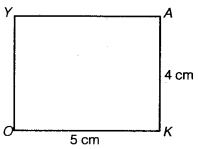
Steps of Construction :
- Draw OK = 5 cm. 5cm
- Draw ∠OKX = 90°.
- With K as centre and radius 4 cm, draw an arc KX at A.
- With A as centre and radius 5 cm, draw an arc.
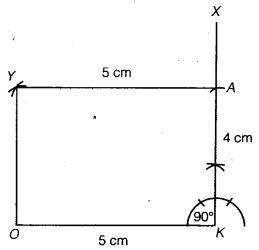
- With O as centre and radius 4 cm, draw another arc cutting the previous arc at Y.
- Join AY and OY.
Then, OKAY is the required rectangle.
Ex 4.5 Class 8 Maths Question 4.
A parallelogram OKAY where OK = 5.5 cm and KA = 42 cm.Solution:
In order to draw a quadrilateral, we need five measurements.But here to draw the parallelogram OKAY, we are given two consecutive sides, i.e., four sides (the opposite sides being equal). So, we need information about one of its elements more. It may be the included angle between the sides or one of the diagonals to construct a unique quadrilateral. So, the required parallelogram cannot be drawn.
NCERT Class 8 Maths
Class 8 Maths Chapters | Maths Class 8 Chapter 4
NCERT Solutions for Class 8 Maths
NCERT Solutions of Maths Class 8 Chapter-wise
Chapter-wise NCERT Solutions for Class 8 Maths
-
NCERT Solutions For Class 8 Maths Chapter 1 Rational Numbers
NCERT Solutions For Class 8 Maths Chapter 2 Linear Equations in One Variable
NCERT Solutions For Class 8 Maths Chapter 3 Understanding Quadrilaterals
NCERT Solutions For Class 8 Maths Chapter 4 Practical Geometry
NCERT Solutions For Class 8 Maths Chapter 5 Data Handling
NCERT Solutions For Class 8 Maths Chapter 6 Squares and Square Roots
NCERT Solutions For Class 8 Maths Chapter 7 Cubes and Cube Roots
NCERT Solutions For Class 8 Maths Chapter 8 Comparing Quantities
NCERT Solutions For Class 8 Maths Chapter 9 Algebraic Expressions and Identities
NCERT Solutions For Class 8 Maths Chapter 10 Visualising Solid Shapes
NCERT Solutions For Class 8 Maths Chapter 11 Mensuration
NCERT Solutions For Class 8 Maths Chapter 12 Exponents and Powers
NCERT Solutions For Class 8 Maths Chapter 13 Direct and Indirect proportions
NCERT Solutions For Class 8 Maths Chapter 14 Factorisation
NCERT Solutions For Class 8 Maths Chapter 15 Introduction to Graphs
NCERT Solutions For Class 8 Maths Chapter 16 Playing with Numbers

Post a Comment
इस पेज / वेबसाइट की त्रुटियों / गलतियों को यहाँ दर्ज कीजिये
(Errors/mistakes on this page/website enter here)